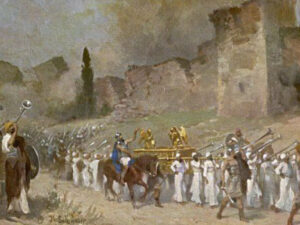The Other Promised Land: The Forgotten Jewish Exodus to Texas

TRENDING
8 min read
Long before Israel became a state, a bold plan aimed to settle thousands of Russian Jews in Galveston, Texas. Assimilation nearly buried the story.
One day in 1895, a British Jewish writer named Israel Zangwill answered a knock on his door. Outside stood a tall, dark-haired Jewish journalist who’d traveled from Vienna. “I am Theodor Herzl,” the stranger announced. “Help me rebuild the Jewish State.”
This startling reminiscence occurs near the beginning of Melting Point: Family, Memory, and the Search for a Promised Land by Rachel Cockerell. It tells the story - using snippets of diaries, newspaper articles, letters, and interviews from the period - of how Theodore Herzl galvanized world Jewry to build the modern State of Israel in the ancient Land of Israel, then a neglected corner of the Ottoman Empire.
It also tells the story of Cockerell’s great grandfather David Jochelman, who became disillusioned with the slow pace of founding the Jewish state, and embarked on a plan of his own: bringing thousands and thousands of Russian Jews to a different sort of “Promised Land”: Galveston, Texas, where he eventually helped 10,000 start new lives.
 Rachel Cockerell
Rachel Cockerell
“I tell people it’s a book about bringing Russian Jews to Texas,” Cockerell explained to Aish.com, but it’s also about the way Cockerell’s great grandfather’s vision led his family to embrace assimilation and a loss of their Jewish identity.
Zionist Congress
By the time Theodore Herzl knocked on Israel Zangwill’s door in London, he’d come to understand that Jews desperately needed a country to call their own.
 David Jochelman and his wife Tamara
David Jochelman and his wife Tamara
In 1894, Herzl - an upper-class, largely assimilated Jewish newspaper reporter from Vienna, was sent to Paris to cover the trial of Capt. Alfred Dreyfus, a Jewish army officer accused of treason. Herzl was used to antisemitism in Vienna; in supposedly modern Paris, he was shocked to see raw hatred against Jews. Public officials and journalists engaged in openly antisemitic attacks on Dreyfus. Outside the courtroom, mobs roamed the streets calling for death to Jews.
The trial spurred Herzl to reconnect with his Jewish identity. He began to see that his life’s work was to establish a Jewish country.
In 1896, Herzl published a pamphlet titled The Jewish State which called for the establishment of a new Jewish country in the ancient Jewish homeland of Israel. Melting Point shows how Herzl’s idea electrified European Jewry. Thousands came together in an annual series of Zionist Congresses in Basel, Switzerland, to debate ways to turn their dream into a reality.
 Theodore Herzl
Theodore Herzl
“Every street corner of this strange, old-fashioned yet massive-built town has its little group of Jews gesticulating passionately and talking at a tremendous rate,” the British newspaper the Pall Mall Gazette reported in 1895 - one of thousands of fascinating snippets and quotes that Cockerell has assembled to tell her story. “The excited throng includes Jews from England, France, Holland, Germany, Austria, Hungary, Galician, Russia, Bulgaria, Poland, Algeria, New York, Baltimore, and four from Palestine itself.”
At the conclusion of the meeting, these Jews from all over the globe announced their plan: to re-establish the Jewish homeland in the ancient Land of Israel.
Rising Violence in Russia
A massive pogrom in the Moldovan town of Kishinev in 1903 gave even more urgency to the debate. After church on Easter, mobs of Christians began hunting Jews throughout the town, beating them up and destroying their property. They murdered 49 Jews, including babies and women, and severely injured 600 more. They raped hundreds of Jewish women and destroyed 1,500 Jewish-owned homes.
 Survivors of the pogrom, sheltered in the Kishinev hospital of Moisei Slutskii
Survivors of the pogrom, sheltered in the Kishinev hospital of Moisei Slutskii
Photographs filled newspapers throughout the world with pictures of the carnage. That was but the start of a deadly new wave of pogroms: within less than a year and a half after the Kishnev pogrom, a further 639 pogroms devastated Jewish communities.
The British Government made a dramatic offer to the nascent Zionist movement: it would offer land in “Uganda” in Africa (in reality, the land lay in modern day Kenya) to the Jewish people to establish a temporary homeland.
The Uganda issue split the Zionist community. Most Jews rejected it, insisting that they wanted to live in the Land of Israel. A small group of activists - led by the British writer Israel Zangwill and Cockerell’s great grandfather David Jochelman - persisted, forming a group called the Jewish Territorial Organization, known as the I.T.O.
When the Uganda plan fell through, they searched the world for a hospitable place where Russian Jews could settle.
The Galveston Movement
Eventually, they chose the Texas city of Galveston as a place to send refugees. Galveston had several advantages. It was still recovering from a massive storm in 1900 which killed thousands of residents and swept away much of the town. In the early 1900s, Galveston was a center of construction with new homes springing up every day. It also already possessed a small but vibrant Jewish community which was eager to welcome the new arrivals.
 Russian Jews on the way to Galveston, Texas
Russian Jews on the way to Galveston, Texas
David Jochelman was put in charge of educating Russian Jews about Galveston. A native of Russia, Jochelman was able to persuade his fellow Jews to move to Texas with ease. He established 150 information centers throughout Russia’s “Pale of Settlement” - the area where Jews were permitted to live - and ensured that Galveston became a household name in large towns and tiny shtetls (Jewish villages) alike.
“Galveston is now a household word and a word of hope throughout the Pale,” declared Jochelman’s partner, Israel Zangwill, in 1907, in one of the many first-person accounts that make up this book. The first Jews set sail from Russia to Galveston in 1907. Even though the trip was longer and more expensive than traveling to New York, Jochelman had so thoroughly persuaded Russian Jews that Galveston was their ideal new home – their Promised Land – that 10,000 Russian Jews eventually made the journey.
 Arrival card for Sara Bernstein, who immigrated from White Russia (now Belarus) via the Galveston Movement. Image available `online and included in accordance with Title 17 U.S.C. Section 107.
Arrival card for Sara Bernstein, who immigrated from White Russia (now Belarus) via the Galveston Movement. Image available `online and included in accordance with Title 17 U.S.C. Section 107.
Not everyone was impressed with the pioneering city once they arrived. One of the immigrants, a man named Alexander Z. Gurwitz who sailed to Galveston then joined his nephew in San Antonio, wrote, “What I saw disturbed me so much that I said to my nephew, ‘Is this your golden America? Muddy streets, unpaved, with miserable little shacks lined along both sides, with small and poverty-stricken shops, just as in Russia’s shtetlech?’”
But by the time these new immigrants arrived in Texas, it was too late to reconsider. They had no choice but to forge new lives in America’s West.
Most stayed in Galveston for only a short time before traveling onward to other sites throughout the region, most notably towns with large Jewish communities like Denver and Omaha. The “Galveston Movement” ended in 1914, when the outbreak of World War I made sea journeys too dangerous.
Cockerell traveled to Galveston to do research for her book where she found only one couple - a local rabbi and his wife, who was descended from Jews that Jochelman sent to Galveston - who recalled the plan. Few of the thousands of Russian Jews who moved there remain in the town. Many who passed through Galveston have long shed their Jewish identities and assimilated into American society.
Legacy of Assimilation
Despite the fact that a century ago her great grandfather was famous in Jewish communities across Europe, author Rachel Cockerell, a non-Jew, had no idea of his legacy for most of her life. It was only once Covid lockdowns began in 2020 that she started researching this book and found out about her family’s contributions to - and early abandonment of - the modern Zionist movement.
Cockerell discovered that her father grew up in a large rambling house in north London with his mother Fanny and his aunt Sonia (Jochelman’s granddaughters). She learned that Sonia married a fellow Jew and in 1951 moved their family to Israel where they’re now living very Jewish lives, with many grandchildren and great grandchildren. Cockerell learned how her Grandmother Fanny and her non-Jewish English husband remained in London and raised Cockerell’s father as “more English than the English.”
Cockerell describes visiting her cousins in Israel and feeling a profound sense of not belonging when she doesn’t understand the Hebrew language they share. “Despite their warmth I always feel like an outsider… I am always aware of a road that forked when” her grandmother turned her back on Jewish life.
Since writing Melting Point, Cockerell now sees herself as a third-generation Russian Jewish immigrant, and has a fuller sense of herself, her family, and her history.
After producing this fascinating, kaleidoscopic new work, Cockerell hopes that she inspires more of us to dig into our own pasts, as well.
Melting Point: Family, Memory, and the Search for a Promised Land by Rachel Cockerell was just published by Farrar, Straus, and Giroux.










